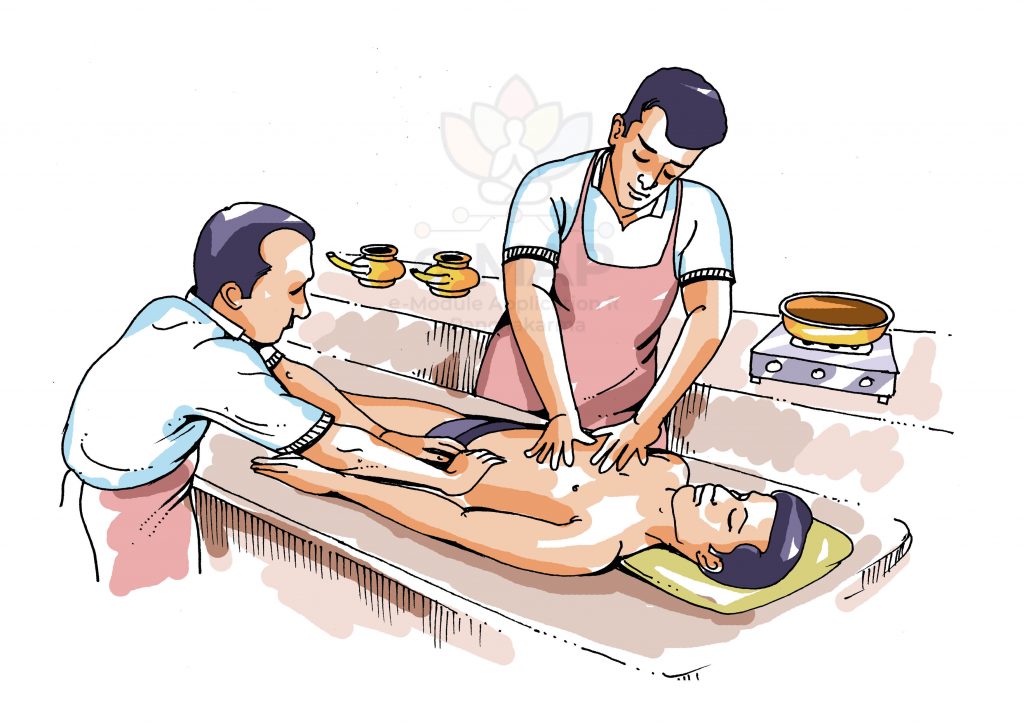
Basic Module 1 - Lesson 7
INTRODUCTION TO PAÑCAKARMA

EXPLANATORY NOTES
Assessment of Koṣṭha and Agni is very much important before conducting Panchakarma procedures. Assessment of Koṣṭha is very important for Panchakarma therapy as mātrā of Śodhana dravya are dependent upon type of Koṣṭha. If Koṣṭha Assessment is not properly done then Samyak Śodhana will not occur. Agni assessment is equally important as good digestive fire is needed to burn the sneha and auṣadha administered. In the Pūrvakarma itself Agnidīpana and Āmapācana is taken care with medicines so that further process like Snehana can be done.
KOṢṬHA PARĪKṢĀ
The word Koṣṭha in Ayurveda applies to both anatomical & physiological entities
Anatomical –Abdominal & thoracic organs
- Antaḥ Koṣṭha – Vaghbata says as Mahā Srotas which incorporates all visceral organs located within thoraco-abdominal and pelvic cavities.
- Koṣṭhaṅgas–Visceral organs
कोष्ठाङ्गानि स्थितान्येषु हृदयं क्लोम फुप्फुसम्|
यकृत्प्लीहोन्दुकं वृक्कौ नाभिडिम्भान्त्रबस्तयः||१२||
Physiological –Nature of bowel habit since birth which originates as an entity of Prakṛti at the time of conception.
कोष्ठः क्रूरो मृदुर्मध्यो मध्यः स्यात्तैः समैरपि|
Koṣṭha which is influenced by Vāta, Pitta and Kapha Doṣas is respectively known as Krūra, Mṛdu and Madhyama Koṣṭha. When all the doṣas have uniform influence then also Koṣṭha is called Madhyama koṣṭha. Here Koṣṭha means the functional nature of alimentary canal.
Krūra Koṣṭha | Vāta | Constipated and not easily Purged |
Mṛdu Koṣṭha | Pitta | Easily Purged |
Madhyama Koṣṭha | Kapha | Solid, Soft faeces move out easily |
MṚDU KOṢṬHA
In this state Koṣṭha is influenced by Pitta and is sara, it exhibits easy purgation even with mild laxatives. This Koṣṭha is of poor absorption and over secretion.
गुडमिक्षुरसं मस्तु क्षीरमुल्लोडितं दधि| पायसं कृशरां सर्पिः काश्मर्यत्रिफलारसम्||
द्राक्षारसं पीलुरसं जलमुष्णमथापि वा| मद्यं वा तरुणं पीत्वा मृदुकोष्ठो विरिच्यते||
विरेचयन्ति नैतानि क्रूरकोष्ठं कदाचन| भवति क्रूरकोष्ठस्य ग्रहण्यत्युल्बणानिला||
उदीर्णपित्ताऽल्पकफा ग्रहणी मन्दमारुता| मृदुकोष्ठस्य तस्मात् स सुविरेच्यो नरः स्मृतः||
Jaggery, Sugar cane juice, mastu (whey), milk, cream of curd, curd, pāyasa, gruel made from tila, rice and māṣa, ghee, juice of kāśmarya, triphala, drākṣā and pīlu, even hot water or newly prepared wine- intake of any of these can cause purgation in a person with Mṛdu Koṣṭha
Their Koṣṭha is afflicted by increased Pitta and less Kapha and least affected with Vāta, hence easily purged.
KRŪRA KOṢṬHA
The Krūra Koṣṭha is influenced by Vāta and will be Rūkṣa. The patient which such a Koṣṭha will be highly constipated. Krūra Koṣṭha extracts more fluid from the material in the lumen and makes it dry. The above said Dravyas like milk and others cannot cause purgation in a person with Krūra Koṣṭha.
MADHYAMA KOṢṬHA
The Madhyama Koṣṭha is influenced by Kapha. There will be predominance of Snigdha, Guru and Sthira guna. Due to sāmavastha of doṣas there will be optimum absorption and secretion.
Also, in this type the characteristics of the bowel are intermediate to that of above two Koṣṭha.
IMPORTANCE OF KOṢṬHA PARĪKṢĀ IN ŚODHANA CHIKITSA
- Assessment of Koṣṭha is important to decide Dravya Pramāna / Auṣadha mātrā.
E.g., Mṛdu Koṣṭha rogi require Mṛdu Auṣadha in minimum dose and Krūra Koṣṭha rogi require Tīkṣṇa Auṣadha in larger dose
Eg; Mṛdu Virecana Dravya, Tīkṣṇa Virecana Dravyas
- In Snehapāna, Sneha-dravya and sneha mātrā (dose) can be decided by Koṣṭha-Parīkṣā.
E.g., Mṛdu Koṣṭha – 3 days, Krūra Koṣṭha – 7 days
- To know the Anupānas
- We can understand the prakṛti by Koṣṭha parīkṣāna
Eg; Mṛdu Koṣṭha person having pitta prakṛti, Krūra Koṣṭha person having Vāta Prakṛti etc.
- To understand in which roga mārga the disease is present – Koṣṭhagata or Śākhāgata or Marmasthisandhi.
- To consider the Doṣa Gati
- To understand the āhāra and vihāra, saṃsarjana krama of the patient and to suggest any changes.
There are thirteen types of Agni told in Samhitas of which five are Bhūtāgni, seven Dhatvāgni and one Jatarāgni. Among which Jatarāgni is of prime importance.
According to Charaka, Agni is assessed on
आहारशक्तितश्चेति आहारशक्तिरभ्यवहरणशक्त्या जरणशक्तया च परीक्ष्या; बलायुषी ह्याहारायत्ते
- Abhyavaharaṇa Śakti – Ability to intake food – How many rotis? How much rice?
- Jaraṇa Śakti – Ability to Digest – When will you feel hunger after a meal?
If the digestion process is proper then at the end of digestion, we can see Jīrṇa Āhāra Lakṣaṇas which are Udgāra Śuddhi, Utsāha, Vegotsarga yātocita, Laghuta, kṣut , Pipāsa
APPLICATIONS OF AGNI PARĪKṢĀ
- When Agni is severely impaired all therapy are contra indicated.
- Sneha Mātrā Nirdhāraṇa
- Virecana Mātrā Nirdhāraṇa
- To formulate Basti Dravya
- Ro decide the duration of Saṃsarjana Krama
IMPORTANT SLOKA
कोष्ठः क्रूरो मृदुर्मध्यो मध्यः स्यात्तैः समैरपि||. (AH. Su 1/9)
Koṣṭha which is influenced byvāta, pitta and kaphadoṣas is respectively known askrūra, mṛduand madhyamakoṣṭha. When all the doṣas have uniform influence then also koṣṭha is called madhyamakoṣṭha.



